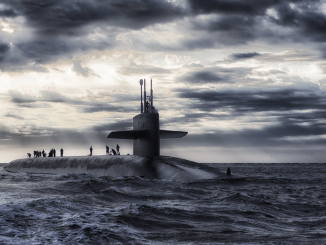 India’s tilt towards adopting counterforce targeting capability is manifested through its increased focus on developing and testing cruise missiles. Unlike the previous years of fast-paced missile testing, India has so far only tested Nirbhay cruise missile in the current year. Defence Research and Development Organization also announced last week that it is planning to test air-launched version of BrahMos missile from Su-30 in the coming days.
India’s tilt towards adopting counterforce targeting capability is manifested through its increased focus on developing and testing cruise missiles. Unlike the previous years of fast-paced missile testing, India has so far only tested Nirbhay cruise missile in the current year. Defence Research and Development Organization also announced last week that it is planning to test air-launched version of BrahMos missile from Su-30 in the coming days.
The other missile variants of Brahmos can be launched from land and sea, but the sea-launched version is yet to be tested. The air-launched variant is most flexible in terms of employment as it can be used as a stand-off weapon and can be deployed against air-bases, infrastructure and against artillery and fixed installations. This assertion proves to be true as the recent news reports claim that the air variant will be used for Balakot-type air strikes.
Initially the missile had a range of 290 km; however, after getting the membership of Missile Technology Control Regime (MTCR), India has extended the range to 450 km. There are reports verifying that the range will further be extended to 800 km. That said, the range of the missile system becomes somewhat irrelevant if these are to be launched from mobile platforms like fighter jets or submarines. In such cases, the reach of these missiles is determined by the position that these launch platforms can assume before firing the missiles. For instance, the air-launched version if launched from closer to the border will have greater reach compared to the missile launched from a ground platform.
Being an Indo-Russian joint venture, the range of BrahMos missile system was carefully kept at 290 km, i.e. just 10km under the range allowed by the MTCR. However, that has changed with India becoming a member of the MTCR. The missile is now set for testing at higher ranges. An even worrying development is the fact that the missile will be capable of carrying nuclear warheads – something that the MTCR is set out to discourage through limitations on payload and range. The delivery of 42 Su-30 aircraft armed with BrahMos cruise missiles to Indian Strategic Force Command (SFC) leaves no uncertainty that the missile will be deployed in a nuclear role.
Designation of a nuclear role to BrahMos should constitute a clear violation of the MTCR guidelines. More so, the arrangement would raise questions over Russian adherence to the NPT under which it is not supposed to help a non-nuclear weapon state (India – as per the NPT definition) with nuclear delivery systems.
In a conflict situation, deployment of BrahMos equipped fighter jets would only increase the chances of misperceptions and miscalculations. Indian adversaries would likely assume that the missile is meant for a nuclear role even if India means otherwise. Some analysts have observed that BrahMos missiles could be useful in Balakot-like strikes. It is not clear if India would use nuclear warheads for such strikes and how would these strikes comply with Indian policy of No First Use (NFU) of nuclear weapons.
India has tried to present the unfolding of recent Pulwama crisis and the claimed Balakot strikes as the new normal. India appears to be building the case that it will not hesitate from taking similar actions in future. This depicts India’s casual attitude towards the potential of escalation that this region holds by virtue of the presence of nuclear weapons and the dangerous doctrines that India promulgates. The crisis would not have de-escalated the way it did, had Pakistan not exercised restraint. If India adopts a similar approach in any future crises, the outcomes may not be the same.
Besides supersonic cruise missiles like BrahMos, India is also developing tactical missiles like Prahaar. These missiles are capable of carrying different types of warheads – potentially making them nuclear capable. Furthermore, Prahaar is destined to replace Prithvi nuclear-capable missiles. It is unlikely that India will replace a nuclear-capable missile with a conventional weapon system. Prahaar is a solid-fueled missile and will provide greater readiness compared to the liquid-fueled Prithvi missiles. Therefore, making it more useful for pre-emptive counterforce targeting rather than use in NFU setting and the policy of massive retaliation policy proclaimed under the current Indian nuclear doctrine.
Indian development and prospective deployment of counterforce weapons in a readily usable state are in contradiction with its currently stated policies. Aiming pre-emptive and counterforce nuclear targeting in a geographically contiguous region is dangerous and destabilizing. The mere threat of pre-emption from the other side led the US and the USSR to cumulatively amass over 60,000 nuclear warheads during the peak of the Cold War. Such policies and signalling can only lead to an increased likelihood of arms buildup in resource-constrained South Asian environment. A state threatened with pre-emptive first strike is likely to move towards higher alert levels and increase the quantity and quality of its nuclear forces. This is, again, not a viable solution to address the fragile state of strategic stability.
Hostilities between India and Pakistan are only on the rise during recent years. In such an environment; development, testing and intention of using lethal weapon systems will only exacerbate crisis instability. These aggressive measures do not solve the underlying issues or manage the deteriorating relationship. Instead, such developments only air the mistrust and add fuel to the fire. Military advances cannot be expected to solve the longstanding disputes that require political solutions. A stable deterrent relationship cannot necessarily be achieved through developing more lethal weapons and denying another side the relative advantages. A durable peace between India and Pakistan can only be achieved if the core issues are resolved. Else, the two countries can eternally continue to try and outcompete the other in military advances.
Tanzeela Khalil is a Visiting Fellow at Atlantic Council, Washington DC. The views expressed here are her own and do not necessarily reflect the policy of her organization in any way.
![]()




What you said is true.but clearly see the Pakistan’s ambitions of terrorism towards India,playing the role of hepless victim to its own terrorist organisations.infact india shouldn’t have signed the No-first use policy,in the recent years terrorist mischief had calmed down,but look at the past,india really suffered and they brainwashed the entire kashmiri Muslims creating false propaganda on india,Now Kashmir has become active terrorist war zone,I don’t know what you westerners are thinking about South Asia with your opinionated mind set.but wake up it will never be solved with peaceful and mindful dialogue.you know what’s the best part in this current scenario,USA helped Pakistan to acquire nuclear technology to deter india,leaving Afghanistan gave all the middle eastern terrorists a big boost to create safe havens for terrorists in Afghanistan and pakistan.peaceful nuclear disarmament or whatever you say.its clearly one of many unsolved and stupid mindset of USA and many western countries that is causing this nuclear war phase now and USA is strengthening ties with India to push it away from Russia and to deter china..clearly dude,why don’t you create all the articles you whites have caused this enemity and destruction on this planet and the good news is USA and the western countries are crumbling down slowly, I’m not giving hate comments on you here.but look into the facts because of your poor,visionless actions are caused by you people led to these dire consequences for us,once the Taliban acquire the nuke technology from Pakistan it will be completely different scene.love and hate from India 🖕🤬